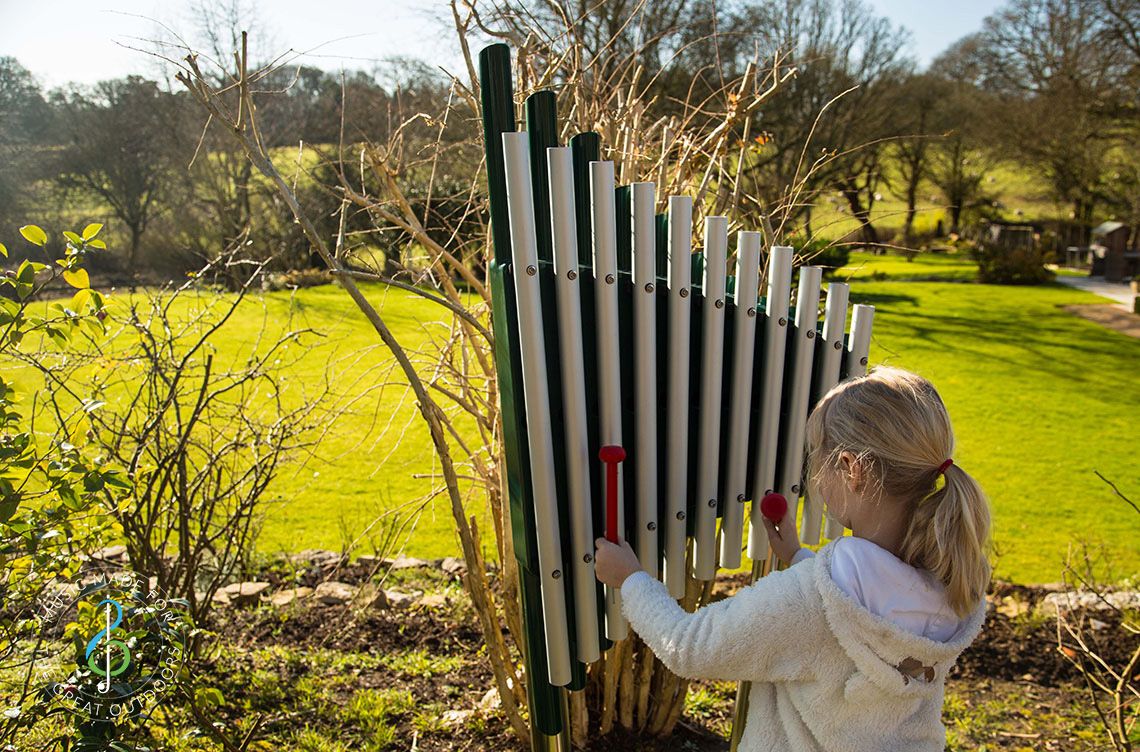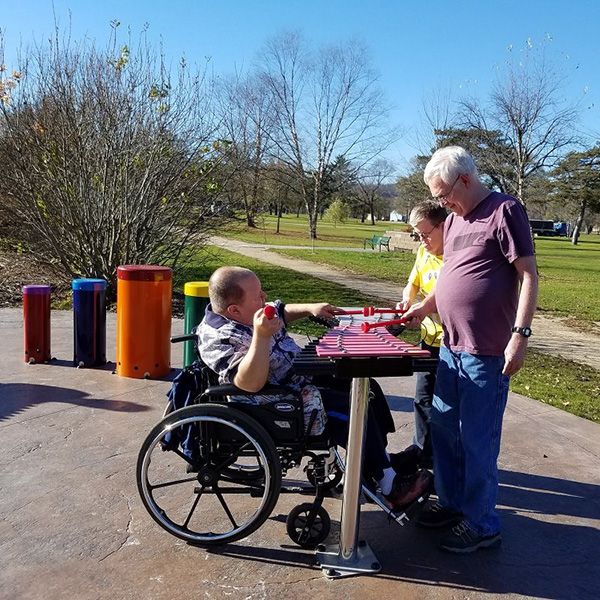How Playground Standards impact Musical Play Equipment & Inclusive Playgrounds
The play equipment industry is constantly changing - with new products, materials and components being introduced to the market every year. New designs are helping to change our approach to the way children play, with play professionals and manufacturers continuing to push the envelope in play equipment design. Conjointly, playground safety has significantly improved over the past 25 years, through considerable improvements in the design of playground equipment and the introduction of industry standards.
There are multiple safety standards across the world, predominately; ASTM (American Society for Testing and Materials) F1487 in the USA, CAN/CSA-Z614 for Children's play spaces and equipment in Canada, the European Standards for Playground Equipment: EN 1176 and EN 1177 and the Australian Standard for Playground Equipment and Surfacing (AS 4685.0:2017).
The new ASTM Standard F1487-17 was recently published with multiple changes from the previous 2011 version. ASTM F1487-17 is the specification that addresses safety and performance standards for various types of public playground equipment in the US and has been significantly harmonized with CAN/CSA-Z614, the Canadian standard for children’s play spaces and equipment. The standard is the distilled wisdom of people with expertise in play, who understand the needs of the organizations they represent and provides the information needed to build and maintain compliant playgrounds.
The change in standards seems to go some way in recognising the diverse and current trends in play equipment design, thinking beyond the typical climber, slide, and swing. With a welcome advance in helping communities succeed in creating inclusive play environments, the standards now recognise new equipment that children of all abilities can easily play on and love - such as musical instruments.
Play is such an important part of child development and inclusive playground design allows children of all ages and abilities to enjoy playing together. Inclusive playground design allows all children to benefit from the playground environment. Musical Instruments can a be a wonderful addition at any inclusive playground.
Here is a summary of the ways the updated ASTM standards impact musical instruments in the playground.
Sharp Points and Sharp Edges
1) Pipe ends on chimes, tubes and other musical instruments no longer need to be capped so long as they pass the sharp edge test (6.2.1 All points and edges on public play equipment shall be tested for sharpness in accordance with the requirements in 16 CFR)
6.2.2 The exposed open ends of all tubing shall be provided with caps or plugs that cannot be removed without the use of tools. Chimes, tubes, and other musical equipment is exempt from this requirement; however, the tube edges shall meet 6.2.1.
Many of the Percussion Play musical instruments have open tube resonators such as; the Harmony ,Cherub, Papilio,Freechimes andSonora . The frequencies of sounds made by open or closed ended pipes differ because of the different ways that air will move at a closed or open end of the pipe. Having outdoor musical instruments exempt from this requirement is good news for music lovers. Caps or bungs dampen the resonance of the chimes, affects the tonal properties and creates a lack-lustre musical experience.

Additionally, we hope this change will reverse the trend of playground designers selecting musical items enclosed with large, sterile, HDPE surrounds. The increase in these surrounds is a result of the test within the standard that is required to determine if a ‘projection’ is a ‘protrusion and/or an entanglement hazard’ on the playground, which has the potential to cause bodily injury to a user who impacts it. Given the potential for impact incidents on play equipment such as swings and slides, this is an extremely important test that requires special gauges of three different sizes to be placed over the bolts or components in the potential impact region, should they extend through the hole beyond the face of the gauges they would fail the standard.
However, as outdoor musical instruments should be situated outside of the play equipment use/fall zones, we feel that applying this same test to musical instruments is both extremely limiting and inappropriate for the situation. Our goal is to create outdoor musical instruments that look like musical instruments and not oversized utilitarian playground items that look and feel inhibitive. We believe more kids should see and have the chance to experience the magic of making music with real musical instruments.
Suspended Hazards
2) The cables used to attach the Mallets or Beaters to the outdoor musical instruments can now be longer to reach across the entire instrument.
There have been many new types of manipulative play components with attached suspended components particularly with outdoor musical instruments. The previous standards made compliance difficult (or impossible) as the permitted length of the cables used to attach percussion mallets to the instruments needed to be long enough to reach across all the notes. However, the standard referring to ‘suspended hazard requirements’ has now been modified to make this easier. The revision now allows for necessary connecting devices (including mallets on cables or chains) to be longer and can now be up to 24 inches (609 mm), but must not be attached any higher than 27 inches (686 mm) above the underlying surface. These manipulative parts are also exempt from meeting the projection criteria using the large 3-inch interior diameter projection gauge, since falling on or running into a larger projection that could damage internal organs in the child’s abdomen, are highly unlikely. The use of the smaller gauges still applies.

6.3.2.1 Exemption to Protrusion Criteria—A manipulative device attached to a rope, cable, or chain is exempt from meeting the projection criteria using the large 3-in. (76.2 mm) interior diameter projection gauge. The use of the smaller gauges still applies
6.6.2.5 For ground level components, ropes, chain or cable used to attach manipulative components (for example, Mallet for chime panel) to play panels or similar activities shall not be longer than 24 in. (609 mm). The attachment point of the cable to the panel shall not be higher than 27 in. (686 mm) above the underlying surface.
Playground Layouts
The previous revision of the standards clarified the definition of public-use play equipment layouts, confirming that all play equipment would no longer require the same designated play surface. This made adding musical instruments to existing play areas as creative, inclusive extras so much easier as you did not need to extend the existing safer surfacing area or resurface entirely.
Children of all abilities and ages can join in together with outdoor musical activities and combining old equipment with new concepts can rejuvenate a play area. Adding musical instruments into your existing playground is a relatively easy way to diversify your play area, bringing inclusive elements to an otherwise non-inclusive playground.
Providing play activities that engage all is vital. By supplying entry paths for wheelchairs and ensuring a certain number of ground-level activities would accommodate a range of disabilities so children with hearing, sight and mobility impairments and sensory processing disorders can all join the fun.
Sensory experiences are valued by every child and play areas shouldn’t just focus on physical movement. Inclusive spaces might also feature comfortable benches, shady areas and sensory rich areas, providing both a different option for play and spaces that are pleasant for parents and caregivers, becoming an engaging safe play area for all.
Stationary Play Equipment
Equipment that is intended for a user to maintain contact with the ground during play has no individual use zone requirements (for example, free standing talk tubes, free standing activity panels, ground level sandboxes and musical instruments) but must still have sufficient space between it and adjacent equipment for play and circulation so that children playing on one piece of equipment will not interfere with children playing on or running to another piece of equipment. All equipment should be arranged to facilitate proper supervision by sight and sound.
Section 9. Playground Layout states ‘There shall be a use zone for each play structure which shall consist of obstacle-free surfacing that conforms to Specification F1292 appropriate for the fall height of the equipment.’

A playground is no good if wheelchair users cannot easily get around the different apparatus and effortlessly enter the playground in the first place. Wide gateways and entrance ways make parks and playgrounds much more accessible, whilst firm and safe pathways link different items of playground equipment together make it simpler for children with visual impairments, walking aids and wheelchairs to get from one part of a playground to another. Some children with special needs may require clear boundaries for each activity, need extra space to move around and ensure a comfortable distance between themselves and others.
Surfacing
As there is no critical fall height on any of our outdoor musical instruments there is no requirement for an impact attenuating surface to be beneath the instruments. However, it is the surfacing that makes or breaks an accessible playground, and choosing play surfaces that are accessible (and can be easily maintained as accessible) is one of the most important decisions during the playground planning and design phase.
There are many options available for playground surfacing, each has their own benefits and costs can vary enormously. However, you only have a few choices if you want a truly inclusive playground. Inaccessible surfaces create barriers for children with disabilities, especially those using wheelchairs, walking frames or crutches. Realistically, it is extremely difficult, if not impossible, to push a wheelchair through many of the ‘loose-fill’ surfaces such as sand, wood or bark chips, preventing children with disabilities from accessing all play elements on the playground. Poured in place rubber surfacing is accessible, and is perfect for customizing a playground’s look, however it is often expensive.
Rubber playground mats are one suitable alternative option that can be easily shaped to fit around existing structures and instruments providing complete ground coverage. They’re wheelchair and pushchair friendly and can also be used for high-traffic walkways and areas such as the end of slides or across grass to protect against erosion.

Harmonizing Standards
There is a current worldwide up-surge in the recognition of the value and importance of outdoor play for children and young people and on ways to give them better inclusive play opportunities. With continued globalization and use of electronic media, we are becoming more connected every day to people around the world, yet we still operate under different playground safety standards. Many playground manufacturers source components in one country, build products in another, and then distribute their products in many others. These products must meet the safety requirements of multiple countries and complying with multiple standards can be confusing and costly.
A sensible way forward would be to harmonize playground equipment safety standards with a goal to find commonalities, identify critical requirements that need to be retained, and provide a common standard across the world. We hope that one day this could happen and thus ensure the safety and fun for all children and young people in playgrounds across the world.
For a comprehensive list of the other playground standards published by ASTM International, please refer to: ASTM Playground Standards
ASTM F1487-17 - Standard Consumer Safety Performance Specification for Playground Equipment for Public Use is available on the ASTM Webstore
CAN/CSA-Z614 for Children's play spaces and equipment can be downloaded by clicking here
Australian Standard AS 4685.0:2017 is available for download here
European Standard CSN EN 1176 all parts + CSN EN 1177 can be downloaded from here
In Summary
We need regulations – nobody wants to move back to a time where playgrounds were unsafe or inaccessible, full of equipment that had the potential to hurt us. Additionally, regulatory reform can be a powerful stimulus to further innovation. Some of the recent changes to the ASTM standard, particularly in recognising musical instruments as play equipment, goes some way in demonstrating that you cannot have a systematic approach of the same standard to all play equipment. Standards which are wrong or inappropriate for the situation will only discourage innovation and inclusive design.
A good playground should provide opportunities for all children to play alongside one another, supporting the physical, social and cognitive development of all children, benefitting everyone. Studies show that peer interaction between people with and without disabilities is enhanced when there are opportunities to interact with peers without disabilities One study found that children are more likely to choose a child with a physical disability to join a play activity when the disability interferes minimally with participation. This finding suggests that children’s inclusion decisions may be influenced by the demands of the play setting. Simply stated, children will engage in play with children with disabilities if they can engage in activities together.
Musical play is inclusive. Everyone can enjoy making music and find their inner musician. Outdoor musical instruments with their simple design combined with their accessibility will enable those with disabilities to make and play music with their peers in the open-air.
